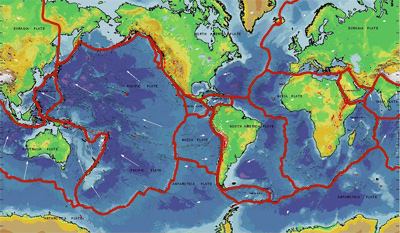This image shows the topography, or shape, of the Earth's surface, on land and below the oceans. Mountain ranges, subduction trenches, tectonic plates, and mid-ocean ridges are all visible in the image.
Click on image for full size
Image from: U.S. Geological Survey
Surface Features of the Earth
This image of the surface of the Earth shows the North and South American continents, as well as the floor of the Pacific Ocean. As can be seen in the image, the ocean floor shows evidence of
The continental regions show evidence of
(Click on the image to see labeled examples of these features.)
These things provide evidence that, unlike other planets, the surface of the Earth is in motion. Motion of the Earth's surface is called plate tectonics.
Compare this active surface with that of Venus, Mars, or Europa.
You might also be interested in:

The Hawaiian Islands are an example of the way some volcanoes are made. A rising hot bubble of material finds it's way into the crust of the Earth from the deep interior, and erupts material unto the surface.
...more
When two sections of the Earth's crust collide, one slab of crust can be forced back down into the deeper regions of the Earth, as shown in this diagram. This process is called subduction. The slab that
...more
Mountains are built through a general process called "deformation" of the crust of the Earth. Deformation is a fancy word which could also mean "folding". An example of this kind of folding comes from
...more
The main force that shapes our planet's surface over long amounts of time is the movement of Earth's outer layer by the process of plate tectonics. This picture shows how the rigid outer layer of the Earth,
...more
Ash is made of millions of tiny fragments of rock and glass formed during a volcanic eruption. Volcanic ash particles are less than 2 mm in size and can be much smaller. Volcanic ash forms in several ways
...more
Cinder cones are simple volcanoes which have a bowl-shaped crater at the summit and only grow to about a thousand feet, the size of a hill. They usually are created of eruptions from a single opening,
...more
Lava can move in broad flat lava flows, or it can move through tight channels or tubes. Lava flows tend to cool quickly and flow slowly. The fastest lava outside of channels moves at about 6 mi/hr an easy
...more















